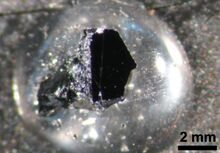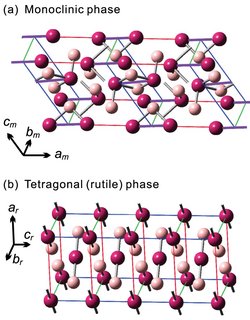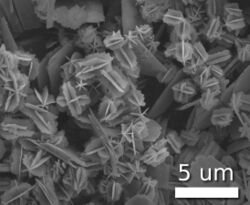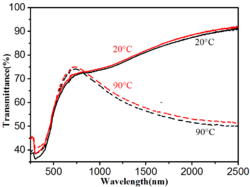Chemistry:Vanadium(IV) oxide

| |
| Names | |
|---|---|
| IUPAC name
Vanadium(IV) oxide
| |
| Other names
Vanadium dioxide
Divanadium tetroxide | |
| Identifiers | |
3D model (JSmol)
|
|
| ChEBI | |
| ChemSpider | |
| EC Number |
|
| 873472 | |
PubChem CID
|
|
| |
| |
| Properties | |
| VO2 | |
| Molar mass | 82.94 g/mol |
| Appearance | Blue-black powder |
| Density | 4.571 g/cm3 (monoclinic) 4.653 g/cm3 (tetragonal) |
| Melting point | 1,967 °C (2,240 K)[1] |
| +99.0·10−6 cm3/mol[2] | |
| Structure | |
| Distorted rutile (<70 °C (343 K), monoclinic) Rutile (>70 °C (343 K), tetragonal) | |
| Hazards | |
| Main hazards | toxic |
| GHS pictograms | 
|
| GHS Signal word | Warning |
| H315, H319 | |
| P264, P280, P302+352, P305+351+338, P332+313, P337+313, P362 | |
| NFPA 704 (fire diamond) | |
| Flash point | Non-flammable |
| Related compounds | |
Other anions
|
Vanadium disulfide Vanadium diselenide Vanadium ditelluride |
Other cations
|
Niobium(IV) oxide Tantalum(IV) oxide |
| Vanadium(II) oxide Vanadium(III) oxide Vanadium(V) oxide | |
Except where otherwise noted, data are given for materials in their standard state (at 25 °C [77 °F], 100 kPa). | |
| Infobox references | |
Vanadium(IV) oxide or vanadium dioxide is an inorganic compound with the formula VO2. It is a dark blue solid. Vanadium(IV) dioxide is amphoteric, dissolving in non-oxidising acids to give the blue vanadyl ion, [VO]2+ and in alkali to give the brown [V4O9]2− ion, or at high pH [VO4]4−.[4] VO2 has a phase transition very close to room temperature (~68 °C (341 K)).[5] Electrical resistivity, opacity, etc, can change up several orders. Owing to these properties, it has been used in surface coating,[6] sensors,[7] and imaging.[8] Potential applications include use in memory devices,[9][10] phase-change switches,[11] passive radiative cooling applications, such as smart windows and roofs, that cool or warm depending on temperature,[12][13][14] aerospace communication systems and neuromorphic computing.[15]
Properties
Structure
At temperatures below Tc = 340 K (67 °C), VO2 has a monoclinic (space group P21/c) crystal structure. Above Tc, the structure is tetragonal, like rutile TiO2. In the monoclinic phase, the V4+ ions form pairs along the c axis, leading to alternate short and long V-V distances of 2.65 Å and 3.12 Å. In comparison, in the rutile phase the V4+ ions are separated by a fixed distance of 2.96 Å. As a result, the number of V4+ ions in the crystallographic unit cell doubles from the rutile to the monoclinic phase.[5]
The equilibrium morphology of rutile VO2 particles is acicular, laterally confined by (110) surfaces, which are the most stable termination planes.[16] The surface tends to be oxidized with respect to the stoichiometric composition, with the oxygen adsorbed on the (110) surface forming vanadyl species.[16] The presence of V5+ ions at the surface of VO2 films has been confirmed by X-ray photoelectron spectroscopy.[17]
Memory effect
In 2022, a to date unique and unknown feature of the material was reported – it can "remember" previous external stimuli[clarification needed] (via structural rather than electronic states), with potential for e.g. data storage and processing, potentially including in neuromorphic computing.[18][19]
Electronic
At the rutile to monoclinic transition temperature (67 °C (340 K)), VO2 also exhibits a metal to semiconductor transition in its electronic structure: the rutile phase is metallic while the monoclinic phase is semiconducting.[20] The optical band gap of VO2 in the low-temperature monoclinic phase is about 0.7 eV.[21]
Thermal
Metallic VO2 contradicts the Wiedemann–Franz law that holds that the ratio of the electronic contribution of the thermal conductivity (κ) to the electrical conductivity (σ) of a metal is proportional to the temperature. The thermal conductivity that could be attributed to electron movement was 10% of the amount predicted by the Wiedemann–Franz law. The reason for this appears to be the fluidic way that the electrons move through the material, reducing the typical random electron motion.[22] Thermal conductivity ~ 0.2 W/m⋅K, electrical conductivity ~ 8.0 ×10^5 S/m.[23]
Potential applications include converting waste heat from engines and appliances into electricity,[24] and windows or window coverings that keep buildings cool.[12] Thermal conductivity varied when VO2 was mixed with other materials. At a low temperature it could act as an insulator, while conducting heat at a higher temperature.[22]
Synthesis and structure
Following the method described by Berzelius, VO2 is prepared by comproportionation of vanadium(III) oxide and vanadium(V) oxide:[25]
- V2O5 + V2O3 → 4 VO2
At room temperature VO2 has a distorted rutile structure with shorter distances between pairs of V atoms indicating metal-metal bonding. Above 68 °C (341 K), the structure changes to an undistorted rutile structure and the metal-metal bonds are broken causing an increase in electrical conductivity and magnetic susceptibility as the bonding electrons are "released".[4] The origin of this insulator to metal transition remains controversial and is of interest both for condensed matter physics[26] and practical applications, such as electrical switches, tunable electrical filters, power limiters, nano-oscillators,[27] memristors, field-effect transistors and metamaterials.[28][29][30]
Infrared reflectance
VO2 expresses temperature-dependent reflective properties. When heated from room temperature to 80 °C (353 K), the material's thermal radiation rises normally until 74 °C (347 K), before suddenly appearing to drop to around 20 °C (293 K). At room temperature, VO2 is almost transparent to infrared light. As its temperature rises it gradually changes to reflective. At intermediate temperatures it behaves as a highly absorbing dielectric.[31][32]
A thin film of vanadium oxide on a highly reflecting substrate (for specific infrared wavelengths) such as sapphire is either absorbing or reflecting, dependent on temperature. Its emissivity varies considerably with temperature. When the vanadium oxide transitions with increased temperature, the structure undergoes a sudden decrease in emissivity – looking colder to infrared cameras than it really is.[33][31]
Varying the substrate materials (e.g., to indium tin oxide), as well as modifying the vanadium oxide coating using doping, straining, or other processes, alters the wavelengths and temperature ranges at which the thermal effects are observed.[31][33]
Nanoscale structures that appear naturally in the materials' transition region can suppress thermal radiation as the temperature rises. Doping the coating with tungsten lowers the effect's thermal range to room temperature.[31]
Uses
Infrared radiation management
Undoped and tungsten-doped vanadium dioxide films can act as "spectrally-selective" coatings to block infrared transmission and reduce the loss of building interior heat through windows.[33][34][35] Varying the amount of tungsten allows regulating the phase transition temperature at a rate of 20 °C (20 K) per 1 atomic percent of tungsten.[33] The coating has a slight yellow-green color.[36] The performance of energy-saving smart windows can be enhanced by combining VO2 with antireflection layers.[37] The technology of low-temperature preparation of V1-xWxO2-based multilayers has been scaled up to industrial dimensions.[38]
Other potential applications of its thermal properties include passive camouflage, thermal beacons, communication, or to deliberately speed up or slow down cooling. These applications could be useful for a variety of structures from homes to satellites.[31]
Vanadium dioxide can act as extremely fast optical modulators, infrared modulators for missile guidance systems, cameras, data storage, and other applications. The thermochromic phase transition between the transparent semiconductive and reflective conductive phase, occurring at 68 °C (341 K), can happen in times as short as 100 femtoseconds.[39]
Passive radiative cooling
Vanadium dioxide is essential to achieving temperature-based 'switchable' cooling and heating effects for passive daytime radiative cooling surfaces without additional energy input. Temperature-based switching can be essential to mitigate potential "overcooling" effects of radiative cooling devices in urban environments, especially those with hot summers and cool winters, making it possible for radiative coolers to also function as passive heating devices when necessary.[40][41]
Phase change computing and memory
The insulator-metal phase transition in VO2 can be manipulated at the nanoscale using a biased conducting atomic force microscope tip,[42] suggesting applications in computing and information storage.[10]
See also
References
- ↑ Haynes, p. 4.98
- ↑ Haynes, p. 4.136
- ↑ "Vanadium dioxide" (in en). https://pubchem.ncbi.nlm.nih.gov/compound/82849#section=Safety-and-Hazards.
- ↑ 4.0 4.1 Greenwood, Norman N.; Earnshaw, Alan (1984). Chemistry of the Elements. Oxford: Pergamon Press. pp. 1144–45. ISBN 978-0-08-022057-4. https://books.google.com/books?id=OezvAAAAMAAJ&q=0-08-022057-6&dq=0-08-022057-6&source=bl&ots=m4tIRxdwSk&sig=XQTTjw5EN9n5z62JB3d0vaUEn0Y&hl=en&sa=X&ei=UoAWUN7-EM6ziQfyxIDoCQ&ved=0CD8Q6AEwBA.
- ↑ 5.0 5.1 Morin, F. J. (1959). "Oxides Which Show a Metal-to-Insulator Transition at the Neel Temperature". Physical Review Letters 3 (1): 34–36. doi:10.1103/PhysRevLett.3.34. Bibcode: 1959PhRvL...3...34M.
- ↑ Li, Yamei; Ji, Shidong; Gao, Yanfeng; Luo, Hongjie; Kanehira, Minoru (2013-04-02). "Core-shell VO2@TiO2 nanorods that combine thermochromic and photocatalytic properties for application as energy-saving smart coatings". Scientific Reports 3: 1370. doi:10.1038/srep01370. PMID 23546301. Bibcode: 2013NatSR...3E1370L.
- ↑ Hu, Bin; Ding, Yong; Chen, Wen; Kulkarni, Dhaval; Shen, Yue; Tsukruk, Vladimir V.; Wang, Zhong Lin (2010-12-01). "External-Strain Induced Insulating Phase Transition in VO2 Nanobeam and Its Application as Flexible Strain Sensor". Advanced Materials 22 (45): 5134–5139. doi:10.1002/adma.201002868. PMID 20842663.
- ↑ Gurvitch, M.; Luryi, S.; Polyakov, A.; Shabalov, A. (2009-11-15). "Nonhysteretic behavior inside the hysteresis loop of VO2 and its possible application in infrared imaging". Journal of Applied Physics 106 (10): 104504–104504–15. doi:10.1063/1.3243286. Bibcode: 2009JAP...106j4504G.
- ↑ Xie, Rongguo; Bui, Cong Tinh; Varghese, Binni; Zhang, Qingxin; Sow, Chorng Haur; Li, Baowen; Thong, John T. L. (2011-05-10). "An Electrically Tuned Solid-State Thermal Memory Based on Metal–Insulator Transition of Single-Crystalline VO2 Nanobeams". Advanced Functional Materials 21 (9): 1602–1607. doi:10.1002/adfm.201002436.
- ↑ 10.0 10.1 Zhou, You; Ramanathan, S. (2015-08-01). "Mott Memory and Neuromorphic Devices". Proceedings of the IEEE 103 (8): 1289–1310. doi:10.1109/JPROC.2015.2431914. https://zenodo.org/record/895565.
- ↑ "Phase-Change Materials and Switches for Enabling Beyond-CMOS Energy Efficient Applications". https://phasechange-switch.org/.
- ↑ 12.0 12.1 Miller, Brittney J. (8 June 2022). "How smart windows save energy". Knowable Magazine. doi:10.1146/knowable-060822-3. https://knowablemagazine.org/article/technology/2022/how-smart-windows-save-energy. Retrieved 15 July 2022.
- ↑ Tang, Kechao; Dong, Kaichen; Li, Jiachen; Gordon, Madeleine P.; Reichertz, Finnegan G.; Kim, Hyungjin; Rho, Yoonsoo; Wang, Qingjun et al. (17 December 2021). "Temperature-adaptive radiative coating for all-season household thermal regulation" (in EN). Science 374 (6574): 1504–1509. doi:10.1126/science.abf7136. PMID 34914515. Bibcode: 2021Sci...374.1504T. https://escholarship.org/uc/item/0fr1q984.
- ↑ Wang, Shancheng; Jiang, Tengyao; Meng, Yun; Yang, Ronggui; Tan, Gang; Long, Yi (17 December 2021). "Scalable thermochromic smart windows with passive radiative cooling regulation" (in EN). Science 374 (6574): 1501–1504. doi:10.1126/science.abg0291. PMID 34914526. Bibcode: 2021Sci...374.1501W.
- ↑ Barraud, Emmanuel (2018-02-05). A revolutionary material for aerospace and neuromorphic computing. https://actu.epfl.ch/news/a-revolutionary-material-for-aerospace-and-neuromo/. Retrieved 2018-05-05.
- ↑ 16.0 16.1 Mellan, Thomas A.; Grau-Crespo, Ricardo (2012). "Density functional theory study of rutile VO2 surfaces". The Journal of Chemical Physics 137 (15): 154706. doi:10.1063/1.4758319. PMID 23083183. Bibcode: 2012JChPh.137o4706M.
- ↑ Manning, Troy D.; Parkin, Ivan P.; Pemble, Martyn E.; Sheel, David; Vernardou, Dimitra (2004). "Intelligent Window Coatings: Atmospheric Pressure Chemical Vapor Deposition of Tungsten-Doped Vanadium Dioxide". Chemistry of Materials 16 (4): 744–749. doi:10.1021/cm034905y.
- ↑ "Researchers discover a material that can learn like the brain" (in en). Ecole Polytechnique Federale de Lausanne. https://techxplore.com/news/2022-08-material-brain.html.
- ↑ Samizadeh Nikoo, Mohammad; Soleimanzadeh, Reza; Krammer, Anna; Migliato Marega, Guilherme; Park, Yunkyu; Son, Junwoo; Schueler, Andreas; Kis, Andras et al. (22 August 2022). "Electrical control of glass-like dynamics in vanadium dioxide for data storage and processing" (in en). Nature Electronics 5 (9): 596–603. doi:10.1038/s41928-022-00812-z. ISSN 2520-1131. https://www.nature.com/articles/s41928-022-00812-z.
- ↑ Goodenough, John B. (1971-11-01). "The two components of the crystallographic transition in VO2". Journal of Solid State Chemistry 3 (4): 490–500. doi:10.1016/0022-4596(71)90091-0. Bibcode: 1971JSSCh...3..490G.
- ↑ Shin, S.; Suga, S.; Taniguchi, M.; Fujisawa, M.; Kanzaki, H.; Fujimori, A.; Daimon, H.; Ueda, Y. et al. (1990). "Vacuum-ultraviolet reflectance and photoemission study of the metal-insulator phase transitions in VO2, V6O13, and V2O3". Physical Review B 41 (8): 4993–5009. doi:10.1103/physrevb.41.4993. PMID 9994356. Bibcode: 1990PhRvB..41.4993S.
- ↑ 22.0 22.1 MacDonald, Fiona (2017-01-28). "Physicists Have Found a Metal That Conducts Electricity but Not Heat". ScienceAlert. http://www.sciencealert.com/physicists-have-found-a-metal-that-conducts-electricity-but-not-heat.
- ↑ Lee, Sangwook; Hippalgaonkar, Kedar; Yang, Fan; Hong, Jiawang; Ko, Changhyun; Suh, Joonki; Liu, Kai; Wang, Kevin et al. (2017-01-27). "Anomalously low electronic thermal conductivity in metallic vanadium dioxide". Science 355 (6323): 371–374. doi:10.1126/science.aag0410. PMID 28126811. Bibcode: 2017Sci...355..371L. http://wu.mse.berkeley.edu/publications/Lee-Science2017.pdf.
- ↑ "Scientists discover material that conducts electricity but no heat" (in en). The Indian Express. 29 January 2017. https://indianexpress.com/article/technology/science/scientists-discover-material-that-conducts-electricity-but-no-heat-4497636/.
- ↑ Brauer, G. ed. (1963) Handbook of Preparative Inorganic Chemistry, 2nd Ed. Academic Press. NY. Vol. 1. p. 1267.
- ↑ New studies explain insulator-to-metal transition of vanadium dioxide, PhysOrg. April 11, 2015.
- ↑ Crunteanu, Aurelian; Givernaud, Julien; Leroy, Jonathan; Mardivirin, David; Champeaux, Corinne; Orlianges, Jean-Christophe; Catherinot, Alain; Blondy, Pierre (2010). "Voltage- and current-activated metal–insulator transition in VO2-based electrical switches: A lifetime operation analysis". Science and Technology of Advanced Materials 11 (6): 065002. doi:10.1088/1468-6996/11/6/065002. PMID 27877369. Bibcode: 2010STAdM..11f5002C.
- ↑ Pattanayak, Milinda; Hoque, Md Nadim F.; Fan, Zhaoyang; Bernussi, Ayrton A. (2018). "Electrical oscillation generation with current-induced resistivity switching in VO2 micro-channel devices". Science and Technology of Advanced Materials 19 (1): 693–701. doi:10.1080/14686996.2018.1521249. Bibcode: 2018STAdM..19..693P.

- ↑ Driscoll, T.; Palit, S.; Qazilbash, M. M. et al. (2008). "Dynamic tuning of an infrared hybrid-metamaterial resonance using vanadium dioxide". Applied Physics Letters 93 (2): 024101. doi:10.1063/1.2956675. Bibcode: 2008ApPhL..93b4101D.
- ↑ Kats, Mikhail A.; Blanchard, Romain; Zhang, Shuyan et al. (21 October 2013). "Vanadium Dioxide as a Natural Disordered Metamaterial: Perfect Thermal Emission and Large Broadband Negative Differential Thermal Emittance". Physical Review X 3 (4): 041004. doi:10.1103/PhysRevX.3.041004. Bibcode: 2013PhRvX...3d1004K.

- ↑ 31.0 31.1 31.2 31.3 31.4 "Natural metamaterial looks cooler when heated". physicsworld.com. 2013-10-25. http://physicsworld.com/cws/article/news/2013/oct/25/natural-metamaterial-looks-cooler-when-heated.
- ↑ Kats, M. A.; Blanchard, R.; Zhang, S.; Genevet, P.; Ko, C.; Ramanathan, S.; Capasso, F. (2013). "Vanadium Dioxide as a Natural Disordered Metamaterial: Perfect Thermal Emission and Large Broadband Negative Differential Thermal Emittance". Physical Review X 3 (4): 041004. doi:10.1103/PhysRevX.3.041004. Bibcode: 2013PhRvX...3d1004K.
- ↑ 33.0 33.1 33.2 33.3 Wang, Chao; Zhao, Li; Liang, Zihui; Dong, Binghai; Wan, Li; Wang, Shimin (2017). "New intelligent multifunctional SiO2/VO2 composite films with enhanced infrared light regulation performance, solar modulation capability, and superhydrophobicity". Science and Technology of Advanced Materials 18 (1): 563–573. doi:10.1080/14686996.2017.1360752. PMID 28970866. Bibcode: 2017STAdM..18..563W.
- ↑ Guzman, G. Vanadium dioxide as infrared active coating. solgel.com
- ↑ "Intelligent Window Coatings that Allow Light In but Keep Heat Out - News Item". Azom.com. 2004-08-12. http://www.azom.com/details.asp?ArticleID=2587.
- ↑ Espinasse, Phillip (2009-11-03). "Intelligent Window Coating Reflects Heat, Not Light". oe magazine. http://oemagazine.com/fromthemagazine/nov04/eyeontech.html.
- ↑ Houska, Jiri (2022-03-21). "Design and reactive magnetron sputtering of thermochromic coatings". Journal of Applied Physics 131 (11): 110901. doi:10.1063/5.0084792. ISSN 0021-8979. https://aip.scitation.org/doi/10.1063/5.0084792.
- ↑ Rezek, Jiří; Szelwicka, Jolanta; Vlček, Jaroslav; Čerstvý, Radomír; Houška, Jiří; Fahland, Matthias; Fahlteich, John (July 2022). "Transfer of the sputter technique for deposition of strongly thermochromic VO2-based coatings on ultrathin flexible glass to large-scale roll-to-roll device" (in en). Surface and Coatings Technology 442: 128273. doi:10.1016/j.surfcoat.2022.128273. https://linkinghub.elsevier.com/retrieve/pii/S0257897222001943.
- ↑ "Timing nature's fastest optical shutter". Physorg.com. 2005-04-07. http://www.physorg.com/news3629.html.
- ↑ Chen, Meijie; Pang, Dan; Chen, Xingyu; Yan, Hongjie; Yang, Yuan (2022). "Passive daytime radiative cooling: Fundamentals, material designs, and applications". EcoMat 4. doi:10.1002/eom2.12153.
- ↑ Wang, Zhaochen; Kim, Sun-Kyung; Hu, Run (March 2022). "Self-switchable radiative cooling". Matter 5 (3). https://www.sciencedirect.com/science/article/abs/pii/S2590238522000431.
- ↑ Jeehoon Kim; Ko, Changhyun; Frenzel, Alex; Ramanathan, Shriram; Hoffman, Jennifer E. (2010). "Nanoscale imaging and control of resistance switching in VO2 at room temperature". Applied Physics Letters 96 (21): 213106. doi:10.1063/1.3435466. Bibcode: 2010ApPhL..96u3106K. https://dash.harvard.edu/bitstream/handle/1/4342532/Hoffman_NanoscaleImaging.pdf?sequence=1.
Bibliography
- Haynes, William M., ed (2011). CRC Handbook of Chemistry and Physics (92nd ed.). CRC Press. ISBN 978-1439855119.
External links
 |





